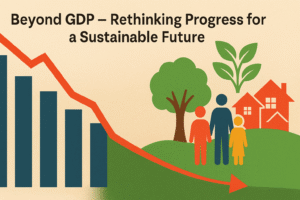In today’s fast-paced world, finding a balance between work and personal life is becoming increasingly important. This quest for balance is often referred to as work-life harmony. But what if we told you there’s an economic perspective to this as well? Welcome to the world of work-life harmony economics.
Understanding Work-Life Harmony Economics
Let’s start with what we mean by work-life harmony. Unlike the traditional work-life balance, which often feels like a tightrope walk, work-life harmony is about blending work and personal life seamlessly. It’s about creating a rhythm that suits you, ensuring both areas support and enrich each other.
From an economic standpoint, work-life harmony can lead to greater productivity, less stress, and a happier, more engaged workforce. In India, this is especially relevant as our work culture often emphasizes long hours and constant availability, which can lead to burnout.

The Economics of Work-Life Harmony
So, why is work-life harmony important for our economy? Here are a few reasons:
Economic Benefits: When employees have a harmonious work-life balance, they tend to be more productive and motivated. This leads to better performance, reduced absenteeism, and lower turnover rates. For example, companies like Tata Consultancy Services (TCS, a multinational IT services company) have implemented flexible work policies, which have shown positive results in employee satisfaction and productivity.
Case Studies: Let’s take a look at Sweden, where companies have experimented with six-hour workdays. The results? Employees reported feeling happier, less stressed, and more productive. Imagine applying such ideas in India—could it transform our workplaces?
Workplace Policies: Many companies are now adopting policies that promote work-life harmony. Infosys (an Indian multinational corporation that provides business consulting and IT services), for instance, offers flexible working hours and work-from-home options. Such policies not only attract talent but also help retain it.
Strategies for Achieving Work-Life Harmony
Achieving work-life harmony requires effort from both individuals and employers. Here are some practical strategies:
Personal Strategies:
- Time Management: Prioritize your tasks and set realistic goals. Tools like Google Calendar can help you plan your day effectively.
- Set Boundaries: Clearly define your work hours and personal time. Inform your colleagues and family about your schedule.
- Self-Care: Don’t neglect your health. Allocate time for physical activity, hobbies, and relaxation.
Workplace Strategies:
- Supportive Environment: Employers should foster a culture of trust and respect. Promote open communication and offer support as necessary.
- Wellness Programs: Companies can offer wellness programs that include mental health support, fitness activities, and stress management workshops.
- Professional Growth: Providing opportunities for skill development and career growth can enhance job satisfaction.
Government Role: The government can also play a role in promoting work-life harmony. Policies such as mandatory paid leave, maternity and paternity benefits, and childcare support can make a significant difference. In India, the Maternity Benefit (Amendment) Act, of 2017, which increased maternity leave from 12 to 26 weeks, is a step in the right direction.
The Role of Technology in Work-Life Harmony
Technology has its advantages and disadvantages. Here’s how to use it effectively:
Positive Impact: Technology enables remote work, which can significantly improve work-life harmony. Tools like Zoom and Microsoft Teams facilitate virtual meetings, reducing the need for long commutes.
Challenges: However, the downside is that technology can blur the lines between work and personal life. Constant notifications and the expectation to be always available can lead to digital burnout.
Solutions: To avoid this, set boundaries for technology use. Turn off notifications outside of work hours and create a designated workspace at home to separate work from personal life.
Measuring Success in Work-Life Harmony
How do we know if we’re achieving work-life harmony? Here are some indicators:
Indicators of Harmony:
- Job Satisfaction: Are employees happy and engaged at work?
- Productivity Levels: Is there an increase in productivity?
- Employee Health: Are there fewer instances of burnout and stress-related illnesses?
Feedback Mechanisms: Regular feedback from employees can help assess the effectiveness of work-life harmony policies. Surveys and one-on-one meetings are useful tools.
Long-Term Benefits: The long-term benefits of work-life harmony are immense. They include a healthier workforce, lower healthcare costs, and a more sustainable work culture.
Challenges and Solutions
Of course, achieving work-life harmony isn’t without its challenges. Common obstacles include:
Cultural Expectations: In many Indian workplaces, long hours are seen as a sign of dedication. Changing this mindset requires time and effort.
Economic Pressures: Financial constraints can make it difficult for individuals to prioritize work-life harmony.
Lack of Awareness: Many people are simply unaware of the benefits of work-life harmony.

Overcoming Challenges:
- Advocacy: Promote the benefits of work-life harmony through awareness campaigns and educational programs.
- Education: Teach time management and stress management skills in schools and workplaces.
- Community Support: Build support networks where individuals can share experiences and strategies for achieving work-life harmony.
Conclusion
In conclusion, orchestrating a balanced life with work-life harmony economics is not just a dream but an achievable goal. By adopting practical strategies and supportive policies, both individuals and organizations can benefit immensely. It’s time to take steps towards a more harmonious, fulfilling life.
Author’s Note
Thank you for reading! As someone who has experienced the challenges of balancing work and personal life, I hope this blog has provided you with useful insights and practical tips. Keep in mind that work-life harmony is an ongoing journey, not a final goal.
G.C., Ecosociosphere contributor.
Further Reading




